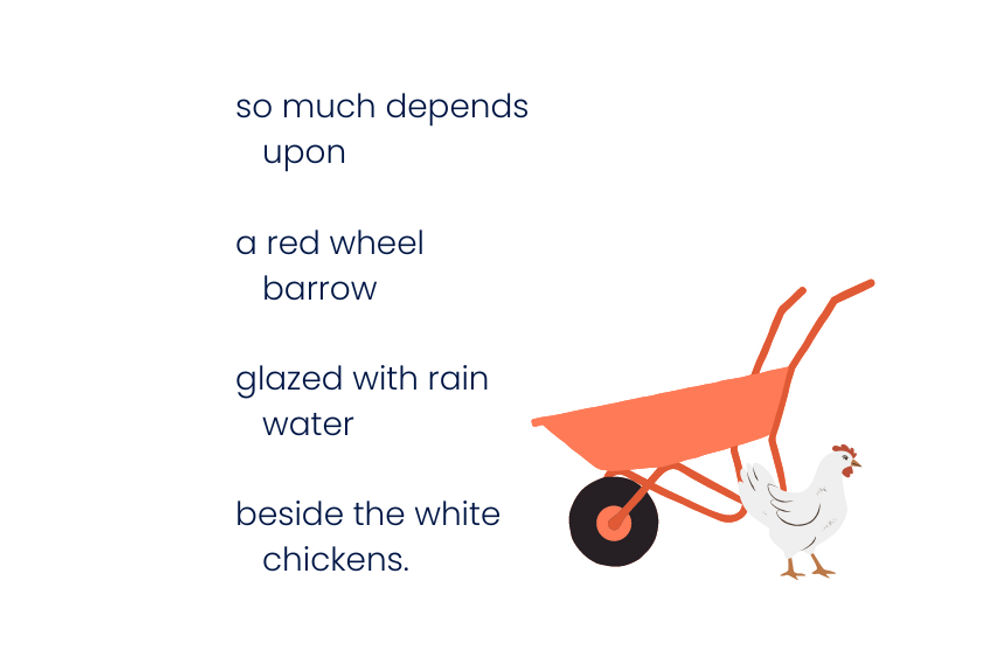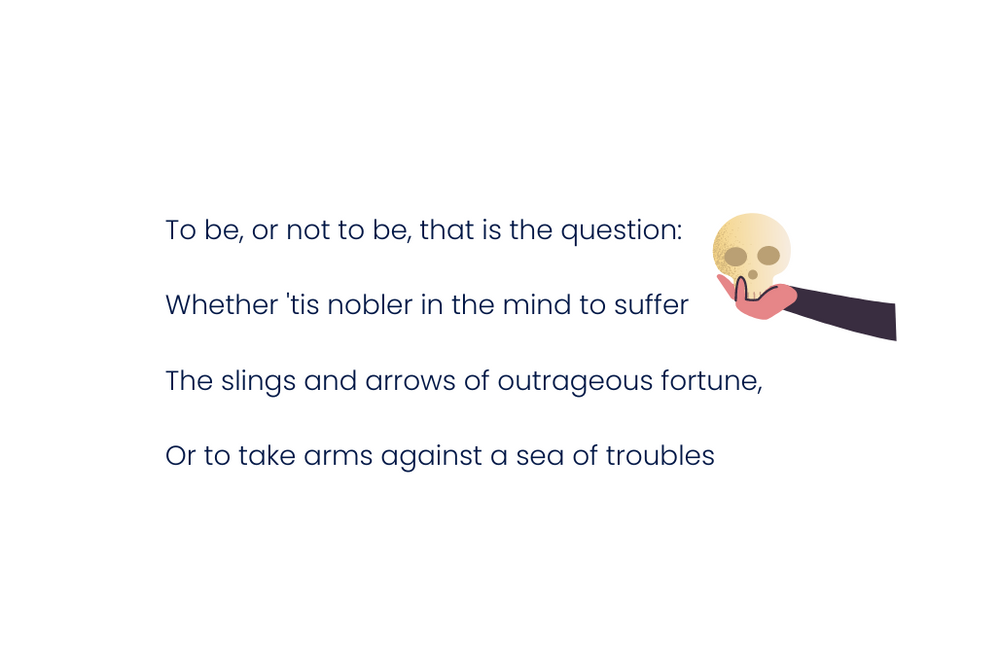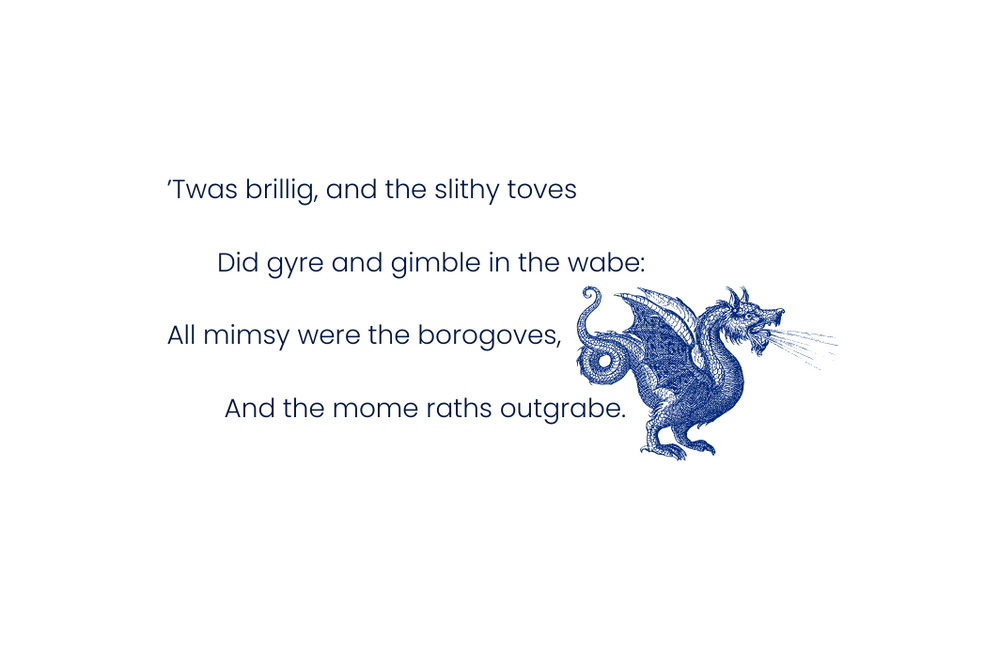When learning about more complex aspects of the English language, learners will encounter the aspects of poetry.
Poetry is a piece of literature that evokes an emotional response in a reader, and this is achieved through form, sound, and metre. In every poem, poetic devices are utilised to change the rhythm and affect the atmosphere. As learners begin to understand poetry, they will be able to identify them through form and language, and then recognise each feature within other forms of writing. Each device allows an author to be in control of how a poem is understood and, as a result, it is crucial that your learners can recognise and utilise poetic devices.
Poetry can be presented in an infinite number of ways using hundreds of different poetic forms. Without these poetic devices, a poem would lose its metre, becoming much more limited when employing metaphors and similes.
What are poetic devices?
A poetic device is a way in which a poet uses words, sounds, or phrases to convey meaning. Although this definition could apply to any technique used in a poem, poetic devices focus on the meanings of words and how meaning is affected by sound and form.
There are many poetic devices, as anything that impacts the sound or form of a poem is a poetic device. They elevate language from the literal to the dynamic, the expansive, and the exciting. Think of them as adding spices to your cooking - adding a new flavour or dimension to your ideas. Learners with a strong grasp of poetic devices produce creative writing that is evocative and skillfully crafted.
Understanding poetic devices is essential for understanding how a poem functions, and there is no way to teach poetry in detail without them. Without a complete understanding of stanzas, metres, or syllables, learners will find it difficult to know the differences between poetry and other forms of writing, and nearly impossible to write poems of their own. Often, poetic devices are the most exciting part of learning about language as they give learners new ways of writing creatively, while a strong grasp of rhythm encourages them to read out loud with more confidence.
What are the most common poetic devices?
Enjambment
Enjambment is one of the most essential poetic devices to understand. From Shakespeare to Heaney, enjambment is a key part of almost every poem.
Enjambment, originating from the French word for “straddle”, is the continuation of a sentence over multiple lines or stanzas. Often, enjambment is used to encourage a reader to move on to the next line and quicken their reading pace, keeping readers excited for what is going to happen next. Sometimes, enjambment is used to create a double meaning - one meaning is given to the complete sentence across stanzas, and another for the single line itself.
Enjambment is used to allow a complex idea to extend beyond a single line and is utilised most in poems which use very few words in each line. This ensures every line is given significance without affecting the larger ideas of the poem. Separating an idea over multiple lines also allows space for new meanings which might otherwise be hidden within a longer sentence. As well as this, enjambment is often essential for rhythm and speed within a poem, allowing ideas to flow alongside a set form or metre. A famous example of enjambment in poetry is “The Red Wheelbarrow” by William Carlos Williams:

When looking at enjambment in detail, it is important to ask a simple question: why not present the poem as a normal sentence instead? Here is the poem, again, without enjambment:
so much depends on a red wheelbarrow glazed with rainwater beside the white chickens.
When presented this way, we spend much more time figuring out the whole sentence rather than focusing on the words within it. Line breaks give space to the components of a poem, allowing each of them to gain more significance. Here a small image, a wheelbarrow beside chickens, is expanded into a poem of eight lines, with each object reaffirmed by the line breaks of “wheel / barrow” and “rain / water”. This poem is an imagist poem, and the spacing allows the reader to create an image in their head as they slowly take in each word and phrase.
Giving learners a strong understanding of poetic devices, such as enjambment, makes it easier for them to think deeply and analytically about word choice and rhythm, producing more sophisticated critical responses.
Caesura
A caesura is a pause in the middle of a line in a poem. These pauses are usually caused by punctuation, such as full stops and commas, and the pause changes depending on which punctuation mark the writer chooses. A full stop, for example, creates a much harsher pause, making the reader stop before reading on. A comma, on the other hand, contrasts the two halves of a sentence more softly.
Caesura can create many effects, such as making a line sound more natural to read, or deliberately making a line sound more unnatural. Writers can break the rhythm of a line to show a change in tone, place focus on a significant word or phrase, or highlight an important moment of drama within a narrative.
Some poets, such as Emily Dickinson, use caesurae in their poetry to varying effects:

These four lines from “I’m Nobody! Who are you?” use exclamation marks, dashes, and question marks to signify pauses, showing the urgency of the narrator as they ask questions to the listener. Caesura is often used to retain rhythm: the above example is iambic.
Similarly, Shakespeare uses caesurae throughout his plays and poetry:

When researching the uses of caesurae in poetry, you may encounter the symbol “||”. This signifies a pause where a caesura has occurred. However, this symbol is unlikely to appear in poetry outside of this context.
Stanza
Stanzas are one of the simplest devices for your students to learn, as every poem has at least one.
A stanza is a group of lines within a poem, separated from the rest of the lines by a space. There is no set number of stanzas that can be used in a poem: some poems are made up of a single stanza, and others are made of hundreds of stanzas that extend over multiple pages. Sometimes stanzas have a rhyme scheme, and this is often seen in poetry aimed at younger audiences. Other stanzas are written in free verse, and stanza breaks are used to change the topic or theme, similar to the way paragraphing is used in other forms of writing.
There are different types of stanzas depending on the number of lines: a stanza with two lines is a couplet, a stanza with three lines is a tercet, and a stanza with four lines is a quatrain. Tercets are most likely to be encountered when your learners are introduced to haikus for the first time, and quatrains are often used in Shakespeare’s sonnets.
A famous example of quatrains is “The Jabberwocky” by Lewis Carroll:

In this poem, a quatrain stanza is used to introduce an ABAB rhyme scheme, allowing the topic and theme to change as the poem progresses.
Stressed syllables
Long before poetry was ever written, it was spoken aloud - for this reason, the rhythm with which it was spoken was one of the most important parts. Without the poem’s rhythm or metre, there can be said to be no difference between poetry and normal speech.
In the modern day, poems do not necessarily need a strict metre to be classed as a poem, but metre is still one of the most important devices in poetry to learn. To understand metre, however, your learners must first understand stressed and unstressed syllables.
A syllable is a beat, or sound, within a larger word. Stressed and unstressed syllables make up every word in the English language. For example, “dog” is a single-syllable word, whereas “banana” has three syllables: ba-na-na.
As well as having specific syllables, the way we stress certain syllables changes the meaning of the word completely. Encourage your learners to stress different syllables in “banana” as a class: “ba-NA-na”, “ba-na-NA”, or “BA-na-NA”. Only one of them is correct. Would your learners be able to recognise words others were saying if different syllables were stressed?
As your learners practise mispronouncing words like this, they gain awareness of how stressed and unstressed syllables work together to make a sentence flow. As they become more confident, they can begin to understand how these stressed syllables can be manipulated to create a poetic rhythm.
When speaking, we often add stress to words to create new meanings or implications. Many phrases don’t have a clear meaning unless we stress them. For example, “Don’t put that there,” is a sentence that changes meaning for every different syllable that is stressed.
Poetry often manipulates the stressed and unstressed syllables in a sentence to change the meaning of a word or change the metre in a line.
Metre and metrical feet
Metre is the application of rhythm within a poem; it refers to the pattern of syllables that give a line a particular sound. A metrical foot is a group of similar-sounding syllables that are repeated within a line of verse. Iambic tetrameter, for example, means that there are three groups of iambs in a line. Throughout secondary education, your learners are likely to encounter these five metrical feet:
- Iambic means an unstressed syllable followed by a stressed syllable. This includes words such as “ascend” or “guitar”, or small phrases like “to go” or “and then”. This metrical foot is used most by classical or romantic poets, such as Wordsworth and Shakespeare.
- Trochaic means a stressed syllable followed by an unstressed syllable, which makes a trochee the exact opposite of an iamb. Words such as “garden” and “burning” are both trochees. The poem “The Tyger” by William Blake uses trochees throughout to highlight the importance of the tiger.
- Dactylic means one stressed syllable followed by two unstressed syllables. This creates an “um-pah-pah” sound. Limericks often use double dactyls in the opening couplet. “The Charge of the Light Brigade” by Alfred Lord Tennyson famously uses dactyls to increase the pace of the poem as the characters go into battle.
- Spondaic means the use of two stressed syllables. Many hyphenated words are spondees, such as “high-tech” or “short-changed”. Spondaic poems often sound harsher than other kinds of poem, as each word stands out. “Break, break, break” by Alfred, Lord Tennyson uses spondees throughout; phrases such as “break, break”, “cold gray”, and “thy crags” give the poem an aggressive energy. In fact, the word “spondee” is a spondee.
- Pyrrhic is the opposite of spondaic, referring to two unstressed syllables. This metrical foot is common in classical poetry, such as Greek, but is rarely used in modern poetry. Often, pyrrhic metre is used alongside conjunctions, or phrases that sit in the middle of a line. There are two examples of pyrrhic metre in Lord Byron’s Don Juan: “My way is to begin with a beginning”.
There are more metrical feet than those listed above, and some poems will use no distinct metrical feet at all. One of the most important skills for a learner is to be able to listen for each kind of metre, especially iambs and dactyls, as these appear most often within the classroom, and to think about what this metrical foot might imply about the writer’s intentions for the poem.
Iambic pentameter
Iambic pentameter is the metre that learners are most likely to encounter during their education. Many famous classical writers use iambic pentameter and, as a result, the sound of this rhythm is commonly associated with the sound of poetry. To understand iambic pentameter, it is important to break down the name itself: iambic means each line is made up of iambs, a metrical foot made up of an unstressed syllable and a stressed syllable. Pentameter, like the word “pentagon”, means that there are five iambs in every line.
Read more about iambic pentameter in our blog on poetic sound devices.
Juxtaposition
Juxtaposition is the placement of two things side by side to highlight their differences. An easy way to think of juxtaposition is as the opposite of a simile: rather than showing how two things might be similar, juxtaposition reveals how different two things are. An angry man walking his fluffy Pomeranianis a juxtaposition as it places two very different things together in an unexpected way. Juxtaposition is often used to be shocking, funny, or to create a strange, uncanny effect. A famous example of juxtaposition is this phrase:
All’s fair in love and war.
The concepts of love and war are complete opposites so, by juxtaposing the two ideas, the phrase asks the reader to discover what makes the two ideas similar. Here is an example of juxtaposition by Shakespeare:

These lines from A Midsummer Night’s Dream show juxtaposition by placing the concepts of tragedy and merriment together, as well as tedium and brevity. Each word is the opposite of what is paired with it; Shakespeare does this to ask the reader whether peace can be found among so many things that do not go together.
A second way juxtaposition can appear in poetry is through the concept of a foil. A foil is a character in a narrative who is the opposite of the protagonist. Imagine writing a story about a grumpy old man: the foil could be a sprightly young grandson whom he meets during the story, creating conflict through the juxtaposition of their differing personalities.
By understanding juxtaposition, your learners are able to analyse the structure of a text and the characters within it, helping them to form a sophisticated critical response to the text.
Activities
Poetic devices can be one of the more difficult concepts for learners when they are first encountered in the classroom. Here are some examples of activities you could explore during your discussions of poetry to help your learners fully understand how poetry works.
Poem building
Poem building encourages your learners to explore poems line by line, as well as experiment with how poems are structured.
Put your learners into groups and provide them with a cut-up poem that has been split by each of its lines. Ask your learners to figure out how the poem originally looked by placing the lines next to each other. Activities such as this encourage your learners to focus on enjambment and form.
As every poem uses lines, this activity can be adapted for any age group or ability. Younger learners can explore nursery rhymes and simpler ideas, whereas older learners can try and rebuild more complex poems. For example, you could try breaking up a Shakespearean sonnet. Encourage your learners to use their knowledge of iambic pentameter and sonnets to figure out how each line fits together.
Sometimes, learners can find analysing poems quite intimidating, especially when they use dated vocabulary and strict form. Encouraging your learners to experiment with how a poem is structured helps them to understand that when analysing a poem, there is no wrong answer.
Break the poem
In this activity, you can explore the idea of enjambment and line breaks by changing or removing them in a particular poem. For example, you could bring a short poem into the classroom as a single sentence without any line breaks. Ask your learners to rewrite the poem with their own line breaks added.
At the end of the lesson, ask your learners why they placed the line breaks where they did, and what effect they thought it gave the poem. It is important to ask your learners why they placed line breaks in certain places to ensure they have a complete understanding. This is also a good way to discuss how line breaks or enjambment can affect meaning depending on where they are placed.
For younger learners, you could remove stanza breaks in a poem, and ask them to figure out where the original stanza breaks were. This could be discovered through a change in theme or the end of a sentence.
Make mistakes
For this activity, bring in some examples of poetry in which you have added mistakes, such as extra syllables in an iambic poem, or incorrect punctuation. Ask your learners to find every mistake in the poem and explain how to fix it.
For more advanced learners, you could make mistakes without telling the class! Try bringing in a Shakespearean sonnet which has too many syllables in some of the lines, or a poem which has line breaks in strange places. Reward your learners for finding mistakes or suggesting improvements to the poem. The more you test your learners this way, the more they will be aware of form and metre when more complex poetry is introduced.
Juxtaposition flashcards
This activity can be played when exploring juxtaposition, similes, or metaphors. Split your class into groups of three or four and ask them to come up with an even number of interesting nouns or phrases, which are written down on a flashcard template.
Once these are written down, swap half of them with another group. With these new phrases, ask each group to place them together and create their own juxtapositional phrases. The silliest phrase could win school points or a sweet!
Exploring comparisons within phrases encourages your learners to think deeper about the similes and contrasting phrases which appear in famous poetry. Some comparisons may seem complicated at first, as if they have nothing in common at all; this activity encourages lateral thinking, helping learners to discover hidden meanings in phrases, and how they relate to the overall meaning of a particular poem.
How Bedrock’s GCSE English curriculum teaches poetry
Bedrock’s GCSE English curriculum features a whole module on poetry and poetic devices. In this module, learners explore some of the poetic devices in this blog - and more - through examples of classic texts. As well as this, writing tasks and critical activities encourage learners to think deeply about authorial intent. Example essay questions are scaffolded; learners not only understand poetic techniques but also practise analysing them in a critical essay, preparing them for written responses in the exam hall.
As well as being an effective method for introducing and mastering poetic devices, Bedrock’s GCSE English curriculum also forms an effective bank of revision knowledge. Unlike regular poetry flashcards, the devices learners encounter in Bedrock’s GCSE English curriculum are stored in their own individual knowledge organiser, allowing them to see their confidence level with each device and track their progress over time.
Not only does this give students visibility over their learning, but data-rich insights in your teacher dashboard inform areas for recapping and deeper instruction, helping you guide your class towards success in their GCSEs and beyond.



